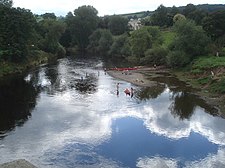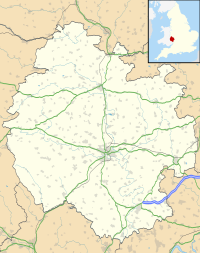
Conwy Castle is a fortification in Conwy, located in North Wales. It was built by Edward I, during his conquest of Wales, between 1283 and 1287. Constructed as part of a wider project to create the walled town of Conwy, the combined defences cost around £15,000, a huge sum for the period. Over the next few centuries, the castle played an important part in several wars. It withstood the siege of Madog ap Llywelyn in the winter of 1294–95, acted as a temporary haven for Richard II in 1399 and was held for several months by forces loyal to Owain Glyndŵr in 1401.

Much Marcle is a village and civil parish in Herefordshire, England, located 7 miles (11 km) north-east of Ross-on-Wye. The 2011 Census recorded the parish's population as 660. The name Marcle comes from the Anglo-Saxon word for a boundary field, mearc-leah. Much, in this case, means large or great, from the Middle English usage of the word.
Shropshire was established during the division of Saxon Mercia into shires in the 10th century. It is first mentioned in 1006. After the Norman Conquest it experienced significant development, following the granting of the principal estates of the county to eminent Normans, such as Roger De Montgomery and his son Robert de Bellême.

Restormel Castle lies by the River Fowey near Lostwithiel in Cornwall, England, UK. It is one of the four chief Norman castles of Cornwall, the others being Launceston, Tintagel and Trematon. The castle is notable for its perfectly circular design. Although once a luxurious residence of the Earl of Cornwall, the castle was all but ruined by the 16th century. It was briefly reoccupied and fought over during the English Civil War but was subsequently abandoned. It is now in the care of English Heritage and open to the public.
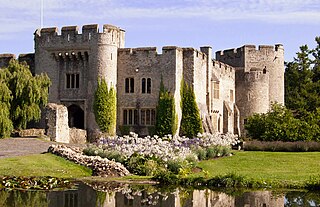
Allington Castle is a stone-built moated castle in Allington, Kent, just north of Maidstone, in England. The first castle on the site was an unauthorised fortification, built during "The Anarchy" (1135–1153) and torn down later in the century when royal control was reasserted. It was replaced by a manor house, which was fortified with royal permission in the 13th century. Various alterations and expansions were made by successive owners over the following two centuries. The property was developed into a fortified compound with six towers at irregular intervals along the curtain wall and domestic buildings in the interior, including one of the first long galleries built in England. In 1554 it was seized by the Crown in the course of dispossessing its owner, Sir Thomas Wyatt the Younger, after the failure of his rebellion against Queen Mary.

Treago Castle is a fortified manor house in the parish of St Weonards, Herefordshire, England. Built c. 1500, it was recorded as a Grade I listed building on 30 April 1986—based on its extant medieval architecture, quadrangle courtyard layout and defensive wall corner towers. Digging on the site revealed solid bedrock, conflicting rumours of a previously filled moat.

Baynard Castle was a moated castle built in the 12th and 13th centuries in the village of Cottingham, East Riding of Yorkshire, England. It was referred to by terms including the 'castle at Cottingham' or 'Stuteville's castle', the term Baynard Castle is common in 19th-century references and later.
Eardisley Castle was in the village of Eardisley in Herefordshire, England, 11 km north-east of Hay-on-Wye. The site of the castle is a scheduled monument.

Goodrich Castle is a Norman medieval castle ruin north of the village of Goodrich in Herefordshire, England, controlling a key location between Monmouth and Ross-on-Wye. It was praised by William Wordsworth as the "noblest ruin in Herefordshire" and is considered by historian Adrian Pettifer to be the "most splendid in the county, and one of the best examples of English military architecture".

Harbottle Castle is a ruined medieval castle situated at the west end of the village of Harbottle, Northumberland, England, 9 miles (14 km) west-north-west of Rothbury overlooking the River Coquet. It is a Scheduled Ancient Monument and a Grade I listed building.

Grosnez Castle is a ruined 14th-century castle in Saint Ouen, situated in Grosnez in the north-west corner of the island of Jersey in the Channel Islands. Philippe de Carteret held it against the French when they held half of Jersey between 1461 and 1467, but it has been a ruin since the mid-16th century.
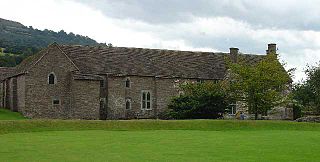
Tretower Court is a medieval fortified manor house in Wales, situated in the village of Tretower, near Crickhowell in modern-day Powys, previously within the historical county of Breconshire or Brecknockshire.
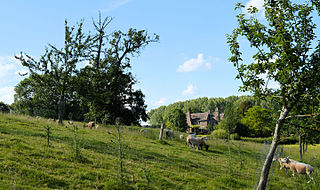
Bredwardine is a village and civil parish in the west of Herefordshire, England.
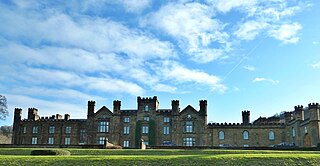
Wilton Castle is an early 19th-century mansion, built on the site of a medieval castle, now converted into luxury residential apartments, situated at Wilton, in Redcar and Cleveland, North Yorkshire, England. It is a Grade II listed building.
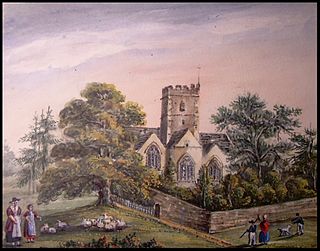
Gwladys ferch Dafydd Gam was a Welsh noblewoman. She was the daughter of Dafydd ap Llewelyn ap Hywel, otherwise known as Dafydd Gam, who was killed at the Battle of Agincourt in 1415.
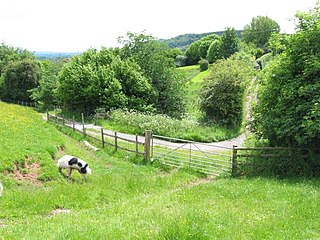
Sir Roger Vaughan of Bredwardine, also known as Roger Fychan or Roger the younger, was a Welsh gentleman, described as having possessed wealth, rank, and high respectability. Roger's seat, Bredwardine Castle, is estimated to have been a strong and formidable fortress, located on the banks of the Wye river in Herefordshire, two miles north of Moccas Court. Bredwardine Castle is thought to have furnished much of the material for the building of Moccas Court.

Caludon Castle is a Scheduled Ancient Monument and Grade I listed building in Coventry, in the West Midlands of England. A second moated site 190 metres (620 ft) to the south is a Scheduled Ancient Monument in its own right. The castle is now a ruin, and all that remains is a large fragment of sandstone wall. What remains of the estate is now an urban park, owned and run by Coventry City Council, but much of it was sold and developed into housing estates in the early 20th century.

Eardisley Park is a country house and estate to the southwest of the village of Eardisley in Herefordshire, England, and approximately 14 miles (23 km) north-west of Hereford.
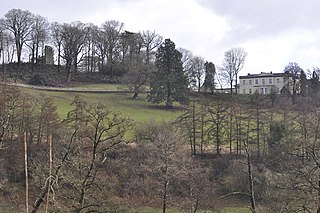
Courtfield, Welsh Bicknor, Herefordshire, England is a country house dating from the early 19th century. The present building stands on the site of a much older mansion which, according to tradition, was home to Henry V for the early years of his life. This house was originally called Greenfield or Greyfield but was renamed Courtfield at that time. Nothing now remains of that building and the present house was erected in the very early 19th century by William Michael Vaughan. The Vaughans had purchased the estate in the 16th century. Staunchly Roman Catholic, and much persecuted in the 17th and 18th centuries; in the mid-19th century Herbert Vaughan, later a cardinal and Archbishop of Westminster, was brought up at the house, born into a large family, an unusually high number of whom entered the church. In 1950 Courtfield was sold by Patrick Vaughan to the Mill Hill Missionaries who ran a House of Formation at the house. In 2010, the mission was closed and the house sold back to the Vaughan family, who had retained ownership of the wider estate. Courtfield is a Grade II listed building. The house is not open to the public.

Edvin Loach and Saltmarshe is a civil parish in north-east Herefordshire, England, and is approximately 15 miles (24 km) north-east from the city and county town of Hereford. The nearest town is Bromyard, 2.5 miles (4 km) to the south-west. Within the parish is a George Gilbert Scott built parish church in the virtually depopulated settlement of Edvin Loach, and the repurposed site of the demolished Saltmarshe Castle.
